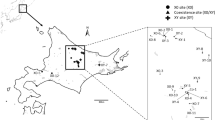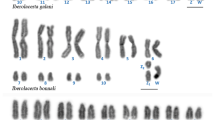Abstract
The endemic grasshopper Cryptobothrus chrysophorus is widely distributed throughout S.E. Australia and its populations display an extensive and spectacular pattern of autosomal variation. While the standard telocentric complement of three long (L1–3), six medium (M4–9) and two short (S10–11) autosome pairs is present throughout most of its range, two quite distinct chromosome “races” can be defined within this species. Populations in the northern part of its distribution (northern N.S.W. and southern Queensland-northern “race”) are differentiated from the remainder (southern “race”) by fixed blocks of distal heterochromatin on autosomes M4, 5, 6, 8 and 9 and by differences in the character of the megameric M7 chromosome. Additionally, while many populations in both races show a polymorphic system of supernumerary segments on the two smallest autosomes (S10–11), that found in the northern “race” is both more variable and more complex. On the other hand all the populations of the southern “race” we have examined are polymorphic for a series of centric shifts which convert telocentrics into acro- or meta-centrics. These occur more commonly in the megameric M7 and the two smallest autosomes (S10–11) although in one population (Forbes Creek, N.S.W.) at least 12 different shifts involving 8 of the autosomes (L3, M4, 5, 6, 7, 8, 9 and S10) are known. By contrast, in the northern “erace” only the small autosomes (S10–11) show centric shifts. These several floating and fixed variants thus involve all chromosomes of the standard set other than the two largest autosomes (L1–2) and the X-chromosome, which appear to be invariate. Finally, morphologically distinct supernumerary (B) chromosomes, intermediate in size between the standard S10 and the M9 elements, are found in both “races” but are especially common in Tasmania, the most southerly point of the species range. These B-chromosomes are partly heterochromatic and partly euchromatic so that they too add to the considerable heterochromatin variation in this species.
Similar content being viewed by others
References
Arrighi, F.E., Stock, A.D., Pathak, S.: Chromosomes of Peromyscus (Rodentia, Cricetidae). V. Evidence of pericentric inversions. Chromosomes today 5, 323–329 (1976)
Baimai, V.: Heterochromatin and multiple inversions in a Drosophila chromosome. Canad. J. Genet. Cytol. 17, 15–20 (1975)
Baimai, V.: Chromosomal polymorphism of constitutive heterochromatin and inversion in Drosophila. Genetics 85, 85–93 (1977)
Beermann, S.: A quantitative study of chromatin diminution in embryonic mitoses of Cyclops furcifer. Genetics 54, 567–576 (1966)
Beermann, S.: The diminution of heterochromatic chromosomal segments in Cyclops (Crustacea, Copepoda). Chromosoma (Berl.) 60, 297–344 (1977)
Britten, R.J., Kohne, D.E.: Repeated sequences in DNA. Science 161, 529–540 (1968)
Duffey, P.A.: Chromosome variation in Peromyscus: a new mechanism. Science 176, 1333–1334 (1972)
Gosden, J.R., Mitchell, A.R., Seuanez, H.N.: Localisation of sequences complementary to human satellite DNAs in man and the hominoid apes. Molec. hum. Cytogenet. (in press, 1977)
Hägele, K.: Differential staining of polytene chromosome bands in Chironomus by Giemsa banding methods. Chromosoma (Berl.) 59, 207–215 (1977)
Hansmann, I.: Structural variability of chromosome 9 in relation to evolution. Hum. Genet. 31, 247–262 (1976)
Hatch, F.G., Bodner, A.J., Mazrimas, J.A., Moore, D.H.: Satellite DNA and karyotypic variations in kangaroo rats (genus Dipodomys). Chromosoma (Berl.) 58, 155–168 (1976)
Hinegardner, R.: Evolution of genome size. In: Molecular evolution, pp. 179–199. Massachusetts: Sinauer Assoc. Inc. 1976
Jackson, R.: Chromosomal evolution in Haplopappus gracilis: a centric transposition race. Evolution (Lawrence, Kans.) 27, 243–256 (1973)
John, B.: The cytogenetic systems of grasshoppers and locusts. II. The origin and evolution of supernumerary segments. Chromosoma (Berl.) 44, 123–146 (1973)
Keyl, H.-G.: Untersuchungen am Karyotypus von Chironomus thummi. I. Karte der Speicheldrüsen Chromosomen von Chironomus thummi thummi und die cytologische Differenzierung der Subspezies Ch. th. thummi and Ch. th. piger. Chromosoma (Berl.) 8, 739–756 (1957)
Keyl, H.-G.: Chromosomenevolution bei Chironomus. I. Strukturabwandlungen an Speicheldrüsen Chromosomen. Chromosoma (Berl.) 12, 26–47 (1961)
Keyl, H.-G.: A demonstrable local and geometric increase in the chromosomal DNA of Chironomus. Experientia (Basel) 21, 191–193 (1965)
Nankivell, R.N.: A terminal association of two pericentric inversions in first metaphase cells of the Australian grasshopper Austroicetes interiosis. Chromosoma (Berl.) 22, 42–68 (1967)
Nur, U.: Synapsis and crossing over within a paracentric inversion in the grasshopper Camnula pellucida. Chromosoma (Berl.) 25, 198–214 (1968)
Pathak, S., Hsu, T.C., Arrighi, F.E.: Chromosomes of Peromyscus (Rodentia, Cricetidae). IV. The role of heterochromatin in karyotypic evolution. Cytogenet. Cell. Genet. 12, 315–326 (1973)
Price, H.J.: Evolution of DNA content in higher plants. Bot. Rev. 42, 27–52 (1976)
Rees, H.: DNA in higher plants. Brookhaven Symp. Biol. 23, 394–418 (1972)
Sannomiya, M.: Cytogenetic studies on natural populations of grasshoppers with special reference to B-chromosomes. I. Gonista bicolor. Heredity (Lond.) 32, 251–265 (1974)
Sharman, G.B.: The cytology of Tasmanian short horned grasshoppers (Orthoptera: Acridoidea). Proc. roy. Soc. Tas. 86, 107–122 (1952)
Schroeder, G.L.: Pericentric inversion polymorphism in Trimerotropis helferi (Orthoptera: Acrididae) and its effect on chiasma frequency. Ph.D. dissertation, Univ. California at Davis (1968)
Sparrow, A.H., Price, H.J., Underbrink, A.G.: A survey of DNA content per cell and per chromosome of prokaryotic and eukaryotic organisms: Some evolutionary considerations. Brookhaven Symp. Biol. 23, 451–493 (1972)
Tobler, H., Smith, K.D., Ursprung, H.: Molecular aspects of chromatin elimination in Ascaris lumbricoides. Develop. Biol. 27, 190–203 (1972)
Waterbury, A.M.: Clinal variation in the karyotype of Peromyscus maniculatus (Wagner) from California. Ph.D. dissertation, Univ. California at Davis (1972)
White. M.J.D.: Animal cytology and evolution. 2nd edit. Cambridge University Press 1954
White, M.J.D.: Some general problems of chromosomal evolution and speciation in animals. Survey Biol. Prog. 3, 109–147 (1957)
Author information
Authors and Affiliations
Rights and permissions
About this article
Cite this article
John, B., King, M. Heterochromatin variation in Cryptobothrus chrysophorus . Chromosoma 64, 219–239 (1977). https://doi.org/10.1007/BF00328079
Received:
Issue Date:
DOI: https://doi.org/10.1007/BF00328079




